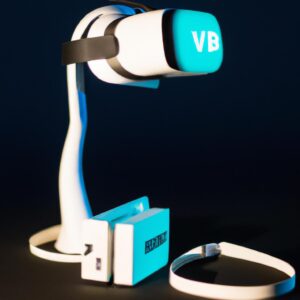Exploring the Most Innovative Uses of VR and AR in Entertainment
The rise of Virtual Reality (VR) and Augmented Reality (AR) have brought about exciting new possibilities in the world of entertainment. These advancements in technology have enabled us to explore a range of different experiences in virtual and augmented reality, from music videos, gaming and films. In this guide we will be exploring some of the most innovative uses of VR and AR in entertainment, the history of how these technologies developed, as well as looking at the potential for the future.
History of Virtual Reality and Augmented Reality
Virtual reality (VR) and augmented reality (AR) have been around since the 1950s, when the first head-mounted displays were created. Even in those early days, there was a sense that these technologies had the potential to create an entirely immersive world for people to explore.
In the 1990s, two major breakthroughs in VR and AR technology advanced their development: the launch of the Virtuality system in 1991, and the release of the first consumer version of the Virtual Boy by Nintendo in 1995. These advancements allowed people to experience virtual environments, albeit on a much more basic level than what is available today.
The modern versions of both technologies have their roots in the work of the great innovators of the 21st century: tech giants like Oculus, HTC, and Microsoft. All three companies have released groundbreaking products that have revolutionized the way we experience virtual reality and augmented reality.
Thanks to the advances in technology, VR and AR have become increasingly accessible. Headsets no longer need to be attached to powerful computers, and there are now several headsets available for various platforms. There are also apps that allow users to interact with virtual worlds using their smartphones.
Benefits and Drawbacks of Gaming
The use of virtual reality (VR) and augmented reality (AR) for gaming has been rapidly growing over the past few years. VR technology immerses players in a 360-degree virtual world, while AR overlays digital graphics on a real-world environment. Both technologies provide an exciting and immersive gaming experience, but they also come with some drawbacks.
One of the biggest benefits of using VR and AR in gaming is enhanced realism. Players can feel as though they are truly inside the game world, without any physical barriers between them and their virtual environment. The visuals, sounds, and even the movement of objects are incredibly realistic, creating an immersive experience that is virtually indistinguishable from reality.
VR and AR also make it possible to create games that are more complex and interactive than ever before. The technology allows developers to create games with a full range of motion, allowing players to move freely throughout the game world. Additionally, it makes it possible to add intricate details, like 3D objects and fully interactive environments, making the game more engaging and longer-lasting.
However, there are some drawbacks to using VR and AR in gaming. For example, the technology is still relatively new, so many developers are still struggling to figure out how to utilize it appropriately. Additionally, the costs associated with developing VR and AR games can be very high, which can be prohibitive for smaller game developers. Finally, the hardware necessary to play these games can be expensive, meaning that not everyone has access to the technology.
Despite these drawbacks, however, the use of VR and AR in gaming offers a vast array of possibilities and opportunities. As developers continue to refine and improve the technology, more players will be able to experience its full potential.
Appearance of VR and AR in Films
Virtual Reality (VR) and Augmented Reality (AR) have been appearing in films since the mid-90s, and have become increasingly popular tools for directors to use in order to create a new level of engagement with viewers. While Virtual Reality relies on fully immersive computer-generated 3D landscapes, Augmented Reality brings real-world images into movies by overlaying them with digital elements.
The most iconic use of VR in film is probably in The Matrix trilogy, where Neo and other characters enter the simulated world of the Matrix in an attempt to extract knowledge from it. In these films, VR serves as a powerful tool for creating alternative worlds where anything can happen. AR has also been featured in films such as Iron Man, where Tony Stark uses a holographic device to design the Iron Man suit, and Minority Report, where Tom Cruise interacts with computers through gestures.
More recently, we have seen VR and AR used in a range of different genres, from horror to sci-fi. Examples include the psychological horror movie A Quiet Place, in which a family reacts to the appearance of unexpected monsters, and Ready Player One, where VR technology provides an escape for Wade Watts from a dystopian future. In these films, VR and AR are used to create exciting and unpredictable worlds that draw viewers in and keep them engaged.
In addition to the movies mentioned above, there have been numerous other examples of VR and AR being used in films, from small independent films to Hollywood blockbusters. It’s clear that the possibilities afforded by these technologies are only just beginning to be explored, and filmmakers are continuing to push the boundaries of what can be achieved. As this technology develops, we can expect to see even more imaginative and exciting ways VR and AR can be used in films.
Music, Television and Other Forms of Visual Media
Virtual Reality (VR) and Augmented Reality (AR) have had an impact on many forms of visual media. In music, VR and AR have been used to create unique music videos, immersive concerts, and interactive music experiences. In television, these technologies are increasingly being used to bring stories to life. They are also being incorporated into other visual media, such as advertisements, art installations, and even live dance performances.
VR and AR have been used to create music videos with a sense of immersion that captures the emotion of the song. For example, Madonna’s music video for “Living for Love” was filmed in virtual reality, allowing viewers to experience the performance in 360 degrees. VR has also been used to create fully immersive concerts with artists like The Chainsmokers and Billie Eilish that were streamed to fans worldwide.
In television, VR and AR have been used to create a more engaging viewing experience. Game of Thrones, the hit HBO show, used VR to provide an inside look at the set and its unique locations. Fox’s show 9-1-1 uses VR to create a realistic experience for viewers, immersing them in the emergency scenes. Advertisements are also making use of these technologies to create interactive experiences for consumers.
VR and AR are also being used in art installations and in live dance performances. Artist Gabo Camnitzer created an AR-powered sculpture that displayed the changing landscape of human rights. Ryuichi Sakamoto’s exhibition featured an immersive soundscape created with AR. Dance performances have also started to incorporate VR and AR to create unique visuals on stage.
It is clear that these two technologies have already had an impact on many different forms of visual media and will continue to do so into the future. Even now, they are being used to create innovative and engaging experiences that are available to viewers around the world.
Exploration of Casinos and Virtual Reality/Augmented Reality
The gambling industry has been adapting to the times and introducing innovative technologies into the gaming experience. One such technological advancement is the integration of virtual reality and augmented reality into online casino games. This feature has opened up new possibilities for players, allowing them to virtually sit at a table and play live poker with far away opponents.
VR and AR are being used to create an immersive gaming experience. Players can get a stunning 3D view of the tables, pick out their preferred table and get a feel for the virtual environment. They have a good understanding of the game and a realistic view of the dealer’s cards, just like a real physical casino. Additionally, players can use their voices or gestures to select a game and even socialize with other players.
The advantages of these technologies in the online gambling space are immense. It allows for a faster and easier way for players to join and bet in online casinos. It also eliminates the need for a physical casino, eliminating the cost and energy associated with running and maintaining a casino. In addition, it allows for a greater interactivity between players and makes gaming more realistic and engaging.
Although the incorporation of these technologies into casinos is beneficial, there are a few drawbacks. Some players may find the controls confusing and it can be difficult to keep up with the latest technology as it changes quite rapidly. In addition, there are additional costs associated with developing and maintaining the technology that could make it difficult for some casinos to stay in business.
The potential of virtual reality and augmented reality technology in the gambling industry is exciting and could revolutionize the way people play casino games. As this technology continues to develop, it will be interesting to see how its presence will continue to affect the industry and the ways in which we gamble.
Exploring the Future Potential of VR and AR
In recent years, virtual reality (VR) and augmented reality (AR) have become increasingly popular among gamers, filmmakers and other people in the entertainment industry. It is now becoming clear that the potential of these technologies stretches far beyond the world of entertainment – with applications in a variety of industries like healthcare, education and even aerospace engineering. But what does the future hold for VR and AR?
As new technologies are created and improved, it’s likely that these two fields will come together to create something entirely new. In fact, this has already begun to happen – with companies like Microsoft introducing their ‘mixed reality’ concept, which combines both elements of VR and AR into one powerful tool. As more companies invest in research and development of these technologies, we can expect to see increased advancements that provide users with more immersive experiences.
Experts foresee big changes for both fields. For example, there is speculation that AR could eventually become small enough to be incorporated into glasses or contact lenses – allowing us to experience augmented information wherever we go. Some even believe that both VR and AR could eventually become so advanced that they become indistinguishable from real life. This would allow for incredible opportunities – such as exploring other worlds without ever leaving your own home.
It’s clear that huge potential lies within the world of VR and AR. As technology continues to improve, it is highly likely that we will eventually see them combined to create a new, unique and powerful tool that could revolutionize the entertainment industry and beyond.
Conclusion
Virtual Reality (VR) and Augmented Reality (AR) have revolutionized the entertainment industry in recent years. By immersing users in digital spaces, VR has enabled the development of new age games and films. AR, on the other hand, has allowed filmmakers to create more realistic scenes with real-time interactions. With advancements in technology, both technologies have been incorporated into musical videos, television shows, online casinos, and other forms of visual media. Although these technologies are still in their early stages, they have the potential to take entertainment to a whole new level. With VR and AR, the possibilities are endless and it will be exciting to see what the future holds.
comments: 0











